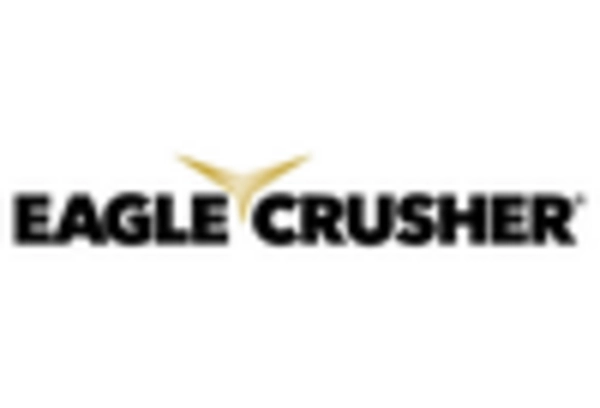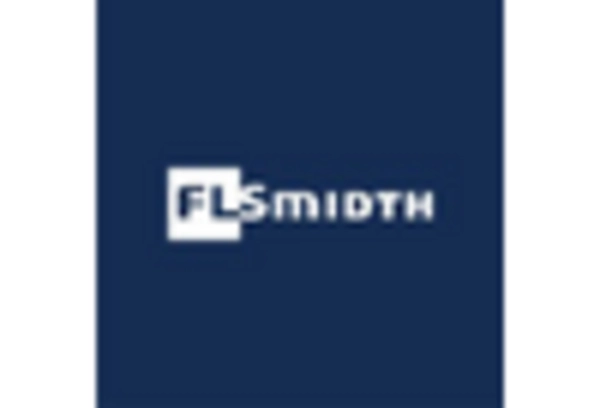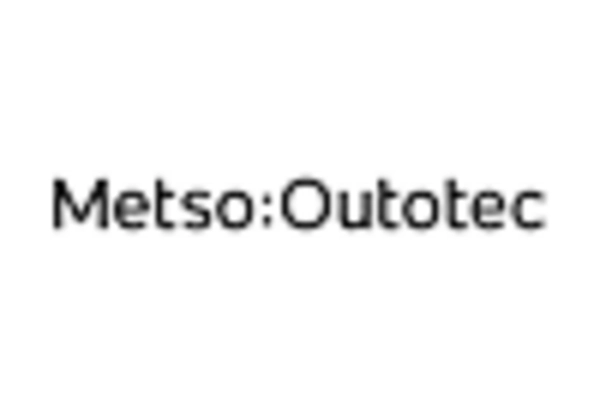Rising Mining Activities
The Hammer Crusher Market is significantly influenced by the rising activities in the mining sector. As mineral extraction becomes increasingly vital for economic development, the demand for efficient crushing solutions rises correspondingly. Hammer crushers are particularly effective in breaking down hard materials such as ores and minerals, making them indispensable in mining operations. Recent statistics suggest that the mining industry is expected to expand at a rate of around 4% annually, which could lead to a heightened requirement for hammer crushers. This trend indicates that as mining operations scale up, the Hammer Crusher Market will likely see a corresponding increase in demand, driven by the need for reliable and efficient crushing equipment.
Growth in Recycling Initiatives
The Hammer Crusher Market is witnessing growth due to the rising emphasis on recycling initiatives across various sectors. As industries and municipalities seek to reduce waste and promote circular economy practices, the demand for efficient crushing equipment to process recyclable materials is increasing. Hammer crushers are particularly effective in breaking down materials such as concrete, asphalt, and metals, making them essential in recycling operations. Recent trends indicate that the recycling market is expected to grow at a rate of approximately 6% annually, which could significantly impact the Hammer Crusher Market. This growth suggests a promising future for manufacturers who can provide innovative solutions tailored to the recycling sector.
Environmental Regulations and Compliance
The Hammer Crusher Market is also affected by stringent environmental regulations aimed at reducing emissions and promoting sustainable practices. As governments worldwide enforce stricter guidelines on industrial operations, manufacturers are compelled to adopt cleaner technologies. Hammer crushers, known for their efficiency in material processing, are being designed to minimize dust and noise pollution. Compliance with these regulations not only enhances the marketability of hammer crushers but also opens up new opportunities for manufacturers to innovate. The increasing focus on sustainability is likely to drive the development of eco-friendly hammer crushers, thereby influencing the Hammer Crusher Market positively.
Increased Demand for Construction Materials
The Hammer Crusher Market is experiencing a surge in demand for construction materials, driven by ongoing infrastructure projects and urbanization. As countries invest in building roads, bridges, and residential complexes, the need for efficient crushing equipment becomes paramount. Hammer crushers are favored for their ability to process a variety of materials, including limestone, coal, and gypsum, which are essential in construction. According to recent data, the construction sector is projected to grow at a compound annual growth rate of approximately 5.5% over the next few years, further propelling the Hammer Crusher Market. This growth indicates a robust demand for machinery that can efficiently produce aggregates and other materials required for construction, thereby enhancing the market's potential.
Technological Innovations in Crushing Equipment
Technological advancements play a crucial role in shaping the Hammer Crusher Market. Innovations such as automation, improved energy efficiency, and enhanced durability are transforming the capabilities of hammer crushers. Manufacturers are increasingly integrating smart technologies that allow for real-time monitoring and optimization of crushing processes. This not only improves operational efficiency but also reduces maintenance costs. The introduction of advanced materials in the construction of hammer crushers is also noteworthy, as it enhances their lifespan and performance. As these technologies continue to evolve, they are likely to attract more investments into the Hammer Crusher Market, fostering growth and competitiveness among manufacturers.


















Leave a Comment